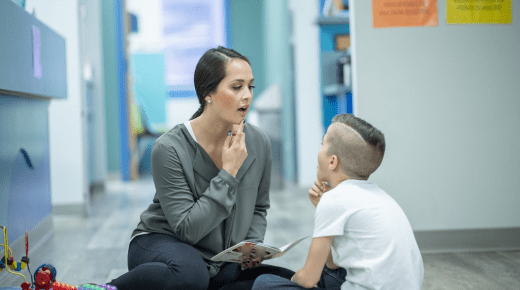1. Introduction to Paediatric Speech Pathology
Paediatric speech pathology focuses on assessing and treating communication disorders in children. Speech pathologists work with children who have difficulties with speech, language, voice, and fluency. The goal is to help children develop effective communication skills essential for social interaction, academic success, and overall well-being.
2. The Importance of Early Intervention
Early intervention in paediatric speech pathology is crucial. Identifying and addressing speech and language disorders early can significantly improve outcomes. Early treatment helps children develop the necessary skills to communicate effectively, reducing the risk of long-term academic and social challenges.
3. Common Speech and Language Disorders in Children
Children may experience various speech and language disorders, including articulation disorders, phonological disorders, receptive and expressive language disorders, stuttering, and voice disorders. Each condition presents unique challenges and requires tailored intervention strategies to address specific needs.
4. Role of a Paediatric Speech Pathologist
A paediatric speech pathologist assesses, diagnoses, and treats speech and language disorders in children. They develop individualized treatment plans, provide therapy sessions, and work closely with families, teachers, and other healthcare professionals to support the child’s communication development.
5. Assessment and Diagnosis of Speech Disorders
Assessment in paediatric speech pathology involves a comprehensive evaluation of a child’s speech, language, and communication skills. This includes standardized tests, observational assessments, and gathering information from parents and teachers. Accurate diagnosis is essential for developing an effective treatment plan.
6. Developing Individualized Treatment Plans
Individualized treatment plans are crucial in paediatric speech pathology. These plans are tailored to each child’s specific needs and goals, incorporating various therapy techniques and activities to target specific areas of difficulty. Regular reviews and adjustments ensure the plan remains effective as the child progresses.
7. Articulation and Phonological Disorders
Articulation disorders involve difficulty producing specific sounds correctly, while phonological disorders involve patterns of sound errors. Paediatric speech pathologists use various techniques, such as auditory discrimination training and articulation therapy, to help children improve their speech sound production.
8. Receptive and Expressive Language Disorders
Receptive language disorders involve difficulty understanding spoken language, while expressive language disorders involve difficulty expressing thoughts and ideas. Therapy focuses on enhancing vocabulary, grammar, comprehension, and expressive abilities through targeted activities and exercises.
9. Fluency Disorders and Stuttering
Stuttering is a common fluency disorder in children characterized by interruptions in the flow of speech. Speech pathologists use techniques such as fluency shaping and stuttering modification to help children develop smoother, more fluent speech patterns, reducing the impact of stuttering on communication.
10. Voice Disorders in Children
Voice disorders in children can involve issues with pitch, volume, or quality of the voice. Treatment may include voice therapy exercises, vocal hygiene education, and techniques to reduce vocal strain. Addressing voice disorders early can prevent long-term damage to the vocal cords.
11. Language Development Milestones
Understanding language development milestones helps identify potential speech and language disorders early. Key milestones include babbling, first words, combining words into simple sentences, and using more complex sentences. Delays or deviations from these milestones may indicate a need for speech pathology intervention.
12. The Role of Parents in Speech Therapy
Parents play a vital role in paediatric speech therapy. They reinforce therapy techniques at home, provide a supportive environment for practice, and collaborate with speech pathologists to ensure consistency and progress. Parental involvement is crucial for the child’s success in developing communication skills.
13. School-Based Speech Pathology Services
School-based speech pathology services provide support to children with speech and language disorders within the educational setting. Speech pathologists work with teachers to integrate therapy goals into the classroom, helping children improve their communication skills and succeed academically.
14. The Impact of Hearing Loss on Speech Development
Hearing loss can significantly affect speech and language development in children. Early detection and intervention are critical. Speech pathologists work with audiologists to provide comprehensive care, including hearing aids, cochlear implants, and specialized therapy to support speech development.
15. Multilingual and Multicultural Considerations
Paediatric speech pathologists must consider multilingual and multicultural factors when assessing and treating children. Understanding the child’s linguistic background, cultural norms, and family dynamics ensures that therapy is culturally sensitive and effective in addressing the child’s unique needs.
16. Technology and Tools in Speech Therapy
Technology plays a significant role in paediatric speech therapy. Tools such as speech-generating devices, apps, and interactive software can enhance therapy sessions, making them more engaging and effective. These tools provide additional resources for children to practice and improve their communication skills.
17. Augmentative and Alternative Communication (AAC)
AAC includes methods and devices that support or replace spoken language for children with severe speech and language impairments. This can include picture boards, speech-generating devices, and sign language. AAC helps children communicate effectively, enhancing their ability to interact and learn.
18. Play-Based Therapy Techniques
Play-based therapy techniques are often used in paediatric speech pathology. These techniques incorporate games, toys, and activities that engage children in a fun and motivating way. Play-based therapy helps children practice communication skills in a natural and enjoyable context.
19. Collaboration with Other Professionals
Collaboration with other professionals, such as occupational therapists, psychologists, and educators, is essential in paediatric speech pathology. A multidisciplinary approach ensures comprehensive care, addressing all aspects of the child’s development and supporting their overall well-being.
20. Managing Speech Disorders in Preschoolers
Preschool-aged children with speech disorders benefit from early intervention. Therapy focuses on foundational skills, such as sound production, vocabulary development, and social communication. Early support helps prepare preschoolers for successful communication as they enter school.
21. Speech Pathology in the Context of Autism
Children with autism spectrum disorder (ASD) often require specialized speech therapy to address communication challenges. Therapy may focus on improving social communication, understanding nonverbal cues, and developing functional language skills. Speech pathologists work closely with families to support children with ASD.
22. Strategies for Home Practice
Home practice is vital for reinforcing skills learned in speech therapy sessions. Strategies include incorporating speech exercises into daily routines, using visual aids, and providing consistent positive reinforcement. Regular practice at home accelerates progress and helps children achieve their communication goals.
23. Evaluating Progress in Speech Therapy
Regular evaluation of progress is crucial in paediatric speech therapy. Speech pathologists use various assessment tools and techniques to monitor improvements, adjust treatment plans, and set new goals. Ongoing evaluation ensures that therapy remains effective and responsive to the child’s needs.
24. Overcoming Challenges in Speech Pathology
Challenges in paediatric speech pathology can include managing diverse caseloads, addressing complex communication needs, and engaging reluctant children. Speech pathologists use creative and flexible approaches to overcome these challenges, ensuring that each child receives the support they need to succeed.
25. The Rewarding Career of a Paediatric Speech Pathologist
A career in paediatric speech pathology is incredibly rewarding. Helping children develop effective communication skills positively impacts their lives, enabling them to express themselves, interact with others, and achieve their full potential. Speech pathologists play a vital role in shaping the future of the children they work with.

